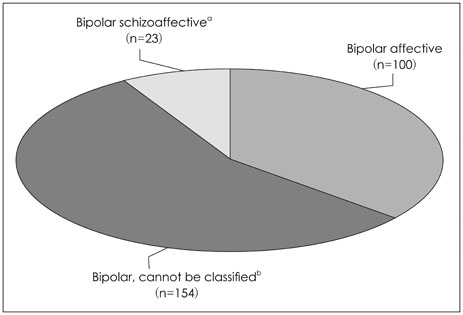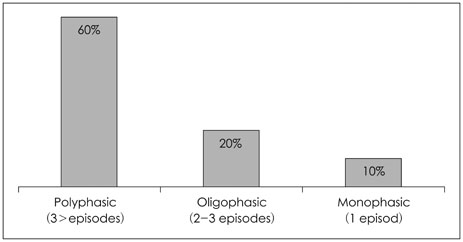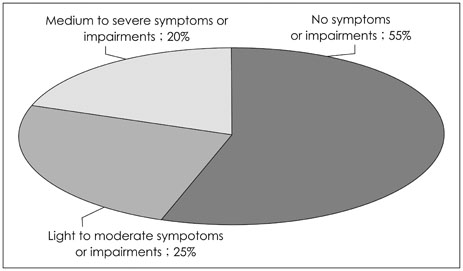Korean J Schizophr Res.
2012 Jun;15(1):5-12. 10.16946/kjsr.2012.15.1.5.
Schizoaffective Disorder
- Affiliations
-
- 1Department of Psychiatry, Psychotherapy and Psychosomatics, Martin Luther University, Halle-Wittenberg, Germany. andreas.marneros@medizin.uni-halle.de
- KMID: 1790741
- DOI: http://doi.org/10.16946/kjsr.2012.15.1.5
Abstract
- Schizoaffective disorders are a controversially discussed but existing nosological category describing an episodic condition meeting the criteria of both schizophrenia and mood disorders and lying on a continuum between these two prototypes. Both DSM-IV and ICD-10 classify them within the group of "schizophrenia, schizotypal and delusional disorders" with ICD-10 not requiring the absence of mood symptoms for a certain time. Cross-sectionally, schizoaffective disorder can be subdivided into schizodepressive, schizomanic and mixed types. In a longitudinal way, unipolar and bipolar types are distinguished. The division into schizo-dominated and mood dominated types is based on the severity and dominance of the schizophreniform symptomatology and implies significant consequences for treatment and prognosis. In addition, concurrent types should be differentiated from sequential types. Schizoaffective disorder is not rare; lifetime prevalence is estimated at 0.3%. About one third of all psychotic patients suffer from schizoaffective disorder. About two thirds of the patients do not only have schizoaffective episodes but also pure schizophreniform or mood episodes or episodes of acute and transient psychotic disorder. In more than 50% of the patients, symptoms remit more or less completely. The others suffer from light, moderate or severe residual states, which might affect their social adaptation. The suicide rate in schizoaffective disorder is about 12%. The treatment of schizoaffective disorder primarily is a combination of antipsychotics and mood stabilizers or antidepressants. Long-term prophylactic treatment mainly consists of antipsychotics and mood stabilizers. Differential diagnosis of schizoaffective disorder is not at all easy. It must be distinguished from psychotic mood disorder, where the psychotic symptoms are mood-congruent. Although DSM-IV allows even mood-incongruent psychotic symptoms in psychotic mood disorder, these cases should better be allocated to schizoaffective disorder. Schizoaffective disorder must also be distinguished from schizophrenia with mood symptoms. In the latter, the mood symptoms are not complete and not so prominent to meet the criteria of a mood episode, or they occur after the schizophreniform have remitted. Sometimes, schizoaffective disorder is mixed up with acute and transient psychotic disorder, although these two conditions do not have very much in common.
Keyword
MeSH Terms
-
Affective Disorders, Psychotic
Antidepressive Agents
Antipsychotic Agents
Deception
Delusions
Diagnosis, Differential
Diagnostic and Statistical Manual of Mental Disorders
Humans
International Classification of Diseases
Light
Mood Disorders
Prevalence
Prognosis
Psychotic Disorders
Schizophrenia
Suicide
Antidepressive Agents
Antipsychotic Agents
Figure
Reference
-
1. WHO. ICD-10 Classification of Mental and Behavioural Disorders. 1991.2. APA. Diagnostic and Statistical Manual of Mental Disorders. 1994. 4th edition. Washington: American Psychiatric Association;(DSM-IV).3. APA. Proposed Draft Revisions to DSM Disorders and Criteria (DSM-V Proposal). 2010. Retrieved on 21 October 2011. from http://www.dsm5.org/Pages/Default.aspx.4. Marneros A, Deister A, Rohde A. Affektive, Schizoaffektive und Schizophrene Psychosen: Eine vergleichende Langzeitstudie. 1991. Berlin, Heidelberg, New York: Springer.5. Marneros A, Pillmann F. Acute and Transient Psychoses. 2004. Cambridge: Cambridge University Press.6. Marneros A, Deister A, Rohde A. Quality of affective symptomatology and its importance for the definition of schizoaffective disorders. Psychopathology. 1989. 22:152–160.
Article7. Marneros A, Goodwin FK. Marneros A, Goodwin FK, editors. Bipolar disorders beyond major depression and euphoric mania. Bipolar Disorders. Mixed States, Rapid Cycling and Atypical Forms. 2005. Cambridge: Cambridge University Press;1–44.
Article8. Marneros A, Goodwin FK. Bipolar Disorders. Mixed States, Rapid Cycling and Atypical Forms. 2005. Cambridge: Cambridge University Press.9. Marneros A, Röttig S, Wenzel A, Blöink R, Brieger P. Marneros A, Goodwin FK, editors. Schizoaffective mixed states. Bipolar Disorders. Mixed States, Rapid Cycling and Atypical Forms. 2005. Cambridge: Cambridge University Press;187–206.
Article10. Marneros A, Deister A, Rohde A. The concept of distinct but voluminous groups of bipolar and unipolar diseases. III. Bipolar and unipolar comparison. Eur Arch Psychiatry Clin Neurosci. 1990. 240:90–95.
Article11. Marneros A, Deister A, Rohde A. The concept of distinct but voluminous groups of bipolar and unipolar diseases. I. Bipolar diseases. Eur Arch Psychiatry Clin Neurosci. 1990. 240:77–84.
Article12. Marneros A, Rohde A, Deister A. The concept of distinct but voluminous groups of bipolar and unipolar diseases. II. Unipolar diseases. Eur Arch Psychiatry Clin Neurosci. 1990. 240:85–89.
Article13. Marneros A. Stolerman I, editor. Schizoaffective disorder. Encyclopaedia of Psychopharmacology. 2010. Heidelberg: Springer;1172–1175.
Article14. Pichot P. Marneros A, Tsuang MT, editors. A comparison of different national concepts of schizoaffective psychosis. Schizoaffective Psychoses. 1986. Berlin, Heidelberg, New York: Springer;8–17.
Article15. Schneider K. Klinische Psychopathologie. 1950. Stuttgart: Thieme.16. Kahlbaum K. Die Gruppirung der psychischen Krankheiten und die Eintheilung der Seelenstörungen. 1863. Danzig: Kafemann.17. Kraepelin E. Die Erscheinungsformen des Irreseins. Zeitschrift für die gesamte Neurologie und Psychiatrie. 1920. 62:1–29.
Article18. Bleuler E. Aschaffenburg G, editor. Dementia praecox oder Gruppe der Schizophrenien. Handbuch der Psychiatrie. Spezieller Teil 4. 1911. Leipzig: Deutike.19. Bleuler M. Die schizophrenen Geistesstörungen im Lichte langjähriger Kranken- und Familiengeschichten. 1972. Stuttgart: Thieme.20. Angst J. Zur Ätiologie und Nosologie endogener depressiver Psychosen. Eine genetische, soziologische und klinische Studie. 1966. Berlin, Heidelberg, New York: Springer.21. APA. Diagnostic and Statistical Manual of Mental Disorders. 1952. 1st edition. Washington: American Psychiatric Association;(DSM-I).22. WHO. ICD-9 Classification of Mental and Behavioural Disorders. 1976. Edinburgh, London, Melbourne, New York, Tokyo: Churchill Livingstone.23. Maier W. Do schizoaffective disorders exist at all? Acta Psychiatr Scand. 2006. 113:369–371.
Article24. Marneros A. Do schizoaffective disorders exist at all? Author Reply. Acta Psychiatr Scand. 2007. 115:162–163.25. Craddock N, O'Donovan MC, Owen MJ. Genes for schizophrenia and bipolar disorder? Implications for psychiatric nosology. Schizophr Bull. 2006. 32:9–16.
Article26. Kelsoe JR. Marneros A, Akiskal HS, editors. The overlapping of the spectra: overlapping genes and genetic models. The Overlap of Affective and Schizophrenic Spectra. 2007. Cambridge: Cambridge University Press;25–42.
Article27. Lichtenstein P, Yip BH, Bjork C, Pawitan Y, Cannon TD, Sullivan PF, Hultman CM. Common genetic determinants of schizophrenia and bipolar disorder in Swedish families: a population-based study. Lancet. 2009. 373:234–239.
Article28. Marneros A, Tsuang MT. Schizoaffective Psychoses. 1986. Berlin, Heidelberg, New York: Springer.29. Marneros A, Tsuang MT. Affective and Schizoaffective Disorders. Similarities and Differences. 1990. New York: Springer.30. Marneros A, Akiskal HS. The Overlap of Affective and Schizophrenic Spectra. 2007. Cambridge: Cambridge University Press.31. Cheniaux E, Landeira-Fernandez J, Lessa Telles L, Lessa JL, Dias A, Duncan T, Versiani M. Does schizoaffective disorder really exist? A systematic review of the studies that compared schizoaffective disorder with schizophrenia or mood disorders. J Affect Disord. 2008. 106:209–217.
Article32. Malhi GS, Green M, Fagiolini A, Peselow ED, Kumari V. Schizoaffective disorder: diagnostic issues and future recommendations. Bipolar Disord. 2008. 10:215–230.
Article33. Perälä J, Suvisaari J, Saarni SI, Kuoppasalmi K, Isometsa E, Pirkola S, et al. Lifetime prevalence of psychotic and bipolar I disorders in a general population. Arch Gen Psychiatry. 2007. 64:19–28.
Article34. Canuso CM, Pandina G. Gender and schizophrenia. Psychopharmacol Bull. 2007. 40:178–190.35. Zarate CA, Tohen M. Shulman KI, Tohen M, Kutcher S, editors. Outcome of mania in adults. Mood disorders across the life span. 1996. New York: Wiley-Liss.36. Vollmer-Larsen A, Jacobsen T, Hemmingsen R, Parnas J. Schizoaffective disorder-the reliability of its clinical diagnostic use. Acta Psychiatr Scand. 2006. 113:402–407.
Article37. Salvatore P, Baldessarini RJ, Tohen M, Khalsa HM, Sanchez-Toledo JP, et al. McLean-Harvard International First-Episode Project: two-year stability of DSM-IV diagnoses in 500 first-episode psychotic disorder patients. J Clin Psychiatry. 2009. 70:458–466.38. Coryell W, Winokur G. Paykel ES, editor. Course and outcome. Handbook of Affective Disorders. 1992. 2nd edition. Edinburgh: Churchill Livingstone.39. Angst J, Preisig M. Course of a clinical cohort of unipolar, bipolar and schizoaffective patients. Results of a prospective study from 1959 to 1985. Schweizer Archiv für Neurologie und Psychiatrie. 1995. 146:5–16.40. Benabarre A, Vieta E, Colom F, Martinez-Aran A, Reinares M, Gasto C. Bipolar disorder, schizoaffective disorder and schizophrenia: epidemiologic, clinical and prognostic differences. Eur Psychiatry. 2001. 16:167–172.
Article41. Angst J. Verlauf unipolar depressiver, bipolar manisch-depressiver und schizoaffektiver Erkrankungen und Psychosen. Fortschr Neurol Psychiatr. 1980. 48:3–30.
Article42. Angst J. Marneros A, Tsuang MT, editors. The course of schizoaffective disorders. Schizoaffective Psychoses. 1986. Berlin, Heidelberg, New York: Springer;63–93.
Article43. Rohde A, Marneros A. Suizidale Symptomatik im Langzeitverhalten schizoaffektiver Psychosen: Symptomkonstellation und soziale Faktoren. Nervenarzt. 1990. 61:164–169.44. Levinson DF, Umapathy C, Musthaq M. Treatment of schizoaffective disorder and schizophrenia with mood symptoms. Am J Psychiatry. 1999. 156:1138–1148.45. McElroy SL, Keck PE Jr, Strakowski SM. An overview of the treatment of schizoaffective disorder. J Clin Psychiatry. 1999. 60:Suppl 5. 16–21. discussion 22.46. Baethge C. Long-term treatment of schizoaffective disorder: review and recommendations. Pharmacopsychiatry. 2003. 36:45–56.
Article47. Mensink GJ, Slooff CJ. Novel antipsychotics in bipolar and schizoaffective mania. Acta Psychiatr Scand. 2004. 109:405–419.
Article48. Jager M, Becker T, Weinmann S, Frasch K. Treatment of schizoaffective disorder - a challenge for evidence-based psychiatry. Acta Psychiatr Scand. 2009. 121:22–32.
Article49. Swoboda E, Conca A, Konig P, Waanders R, Hansen M. Maintenance electroconvulsive therapy in affective and schizoaffective disorder. Neuropsychobiology. 2001. 43:23–28.
Article50. Bauer M, Berghofer A, Bschor T, Baumgartner A, Kiesslinger U, Hellweg R, et al. Supraphysiological doses of L-thyroxine in the maintenance treatment of prophylaxis-resistant affective disorders. Neuropsychopharmacology. 2002. 27:620–628.
Article51. Marneros A, Roettig S, Roettig D, Tscharntke A, Brieger P. The longitudinal polymorphism of bipolar I disorders and its theoretical implications. J Affect Disord. 2008. 107:117–126.
Article
- Full Text Links
- Actions
-
Cited
- CITED
-
- Close
- Share
- Similar articles
-
- Prevalence of the Metabolic Syndrome among Outpatients with Schizophrenia or Schizoaffective Disorder
- How Can We Differentiate Schizoaffective Disorder from Mood Disorder with Psychotic Feature?
- Drug Treated Schizophrenia, Schizoaffective and Bipolar Disorder Patients Evaluated by qEEG Absolute Spectral Power and Mean Frequency Analysis
- Effects of Psychoeducation Program on Insight and Treatment Attitudes in Patients with Schizophrenia, Schizophreniform Disorder, and Schizoaffective Disorder
- Blonanserin-induced Mood Alteration in Schizophrenia and Schizoaffective Disorder: Two Cases




